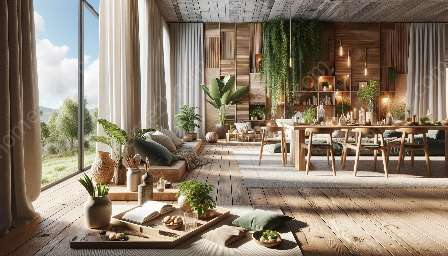Creating accessible bathroom designs that prioritize ergonomics and accessibility while maintaining aesthetic appeal is crucial for ensuring an inclusive and welcoming environment. In this comprehensive guide, we will explore the intersection of accessible bathroom designs with the principles of ergonomics and interior design, providing valuable insights, tips, and ideas for creating an attractive and functional accessible bathroom.
Understanding the Importance of Accessible Bathroom Design
Before delving into specific design elements, it's essential to grasp the significance of accessible bathroom designs. Inclusivity and accessibility are not only ethical imperatives but also legal requirements in many jurisdictions. By creating bathrooms that are accessible to individuals with diverse physical abilities, interior designers and architects can contribute to the creation of more equitable and inclusive spaces. Moreover, prioritizing accessibility can enhance the overall functionality and usability of the bathroom for all users, regardless of their physical capabilities.
Integrating Ergonomics into Accessible Bathroom Designs
Ergonomics is a key consideration in any design, and it becomes even more crucial in accessible bathroom design. The goal of ergonomic design is to optimize the interaction between individuals and their environment, ensuring that spaces and products are tailored to the needs and capabilities of users. When applied to accessible bathroom designs, ergonomic principles guide the selection and placement of fixtures, layout, and the overall user experience.
Optimizing the placement of essential fixtures, such as sinks, toilets, and showers, to accommodate a wide range of users is a fundamental aspect of ergonomic bathroom design. This may involve adjusting the height of fixtures, providing support bars, and ensuring adequate clearance for wheelchair users. Additionally, the selection of non-slip flooring materials, easy-to-reach storage solutions, and lever-style handles for faucets can significantly enhance the usability of the bathroom for individuals with diverse abilities.
Key Considerations for Accessible Bathroom Designs
When designing an accessible bathroom, it's important to consider various elements to ensure both accessibility and aesthetic appeal. Here are some key considerations:
- Spacious Layout: An accessible bathroom should prioritize a spacious layout to allow easy maneuverability for individuals using mobility aids or wheelchairs. Implementing wider doors and ample clear floor space can make a significant difference in the usability of the space.
- Adjustable Fixtures: Selecting fixtures that can be easily adjusted to accommodate individual preferences and needs, such as adjustable-height sinks and showers, is essential for creating a versatile and inclusive bathroom environment.
- Non-Slip Surfaces: Incorporating slip-resistant flooring materials and ensuring that showers and bathtubs have adequate gripping surfaces can enhance safety and accessibility for all users.
- Intuitive Lighting and Controls: Implementing well-designed lighting and user-friendly controls, such as motion-activated lights and easy-to-operate switches, can improve accessibility and convenience in the bathroom.
- Seamless Aesthetic Integration: Integrating accessibility features seamlessly into the overall aesthetic of the bathroom is crucial for creating a visually appealing and inclusive space. This involves thoughtful selection of colors, textures, and materials that complement the design while meeting accessibility requirements.
Harmonizing Accessibility with Interior Design
One of the challenges in accessible bathroom design is harmonizing accessibility features with interior design goals. However, accessible design does not have to compromise the aesthetic appeal of the space. By integrating accessibility features tactfully and creatively, designers can create visually stunning bathrooms that prioritize both form and function.
For instance, selecting elegant grab bars that double as towel racks, incorporating decorative accent tiles with slip-resistant properties, and utilizing sleek and modern fixtures that also prioritize accessibility can seamlessly blend functionality with aesthetic appeal. Additionally, leveraging contrast and visual cues to aid navigation for individuals with visual impairments can enhance the overall accessibility and visual interest of the bathroom.
Customizing Accessible Bathroom Designs
Customization plays a pivotal role in creating accessible bathrooms that meet the specific needs and preferences of users. Interior designers have the opportunity to collaborate closely with clients to understand their unique requirements and tailor the design to optimize accessibility and ergonomics while reflecting the client's personal style and preferences.
From selecting adaptive fixtures and assistive devices to configuring the layout and storage solutions, customization allows for a truly tailored approach to accessible bathroom design. This customization can encompass a wide range of factors, including the height, placement, and functionality of fixtures, as well as the incorporation of personalized accessibility solutions that align with the user's individual needs and abilities.
Future-Focused Accessibility and Ergonomics
As the field of interior design continues to evolve, it is crucial to embrace a future-focused approach to accessibility and ergonomics. Designers and architects should stay abreast of the latest advancements in accessible design, inclusive products, and innovative solutions for creating truly inclusive and inspiring bathroom spaces.
By advocating for universal design principles, accommodating diverse user needs, and collaborating with experts in accessibility, interior designers can lead the way in shaping a more inclusive future for accessible bathroom designs. This forward-looking mindset involves considering emerging technologies, sustainable materials, and adaptable design strategies to ensure that accessible bathrooms not only meet current needs but also anticipate the evolving requirements of users with diverse abilities.
Conclusion
Accessible bathroom designs that prioritize ergonomics and accessibility in tandem with interior design principles play a vital role in fostering inclusive and welcoming environments. By understanding the importance of accessible design, integrating ergonomic considerations, harmonizing accessibility with interior design, and emphasizing customization and future-focused strategies, designers can create attractive and functional bathrooms that cater to the diverse needs and preferences of users. With a commitment to inclusivity and creativity, accessible bathroom designs can serve as testaments to the power of design to elevate the human experience and promote equity in the built environment.




